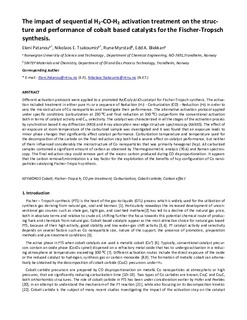| dc.contributor.author | Patanou, Eleni | |
| dc.contributor.author | Tsakoumis, Nikolaos | |
| dc.contributor.author | Myrstad, Rune | |
| dc.contributor.author | Blekkan, Edd Anders | |
| dc.date.accessioned | 2017-10-24T07:28:21Z | |
| dc.date.available | 2017-10-24T07:28:21Z | |
| dc.date.created | 2017-10-23T10:08:31Z | |
| dc.date.issued | 2018 | |
| dc.identifier.citation | Applied Catalysis A : General. 2018, 549 280-288. | nb_NO |
| dc.identifier.issn | 0926-860X | |
| dc.identifier.uri | http://hdl.handle.net/11250/2461577 | |
| dc.description.abstract | Different activation protocols were applied to a promoted Re/Co/γ-Al2O3 catalyst for Fischer-Tropsch synthesis. The activation included treatment in either pure H2 or a sequence of Reduction (H2) – Carburization (CO) – Reduction (H2) in order to vary the microstructure of Co nanoparticles and investigate their performance. The alternative activation protocol applied under specific conditions (carburization at 230 °C and final reduction at 350 °C) outperform the conventional activation both in terms of catalyst activity and C5+ selectivity. The catalyst was characterized in all the stages of the activation process by synchrotron based X-ray diffraction (XRD) and X-ray absorption near edge structure spectroscopy (XANES). The effect of air exposure at room temperature of the carburized sample was investigated and it was found that air exposure leads to minor phase changes that significantly affect catalyst performance. Carburization temperature and temperature used for the decomposition of the carbide on the final reduction step both had a severe effect on catalyst performance, but neither of them influenced considerably the microstructure of Co nanoparticles that was primarily hexagonal (hcp). All carburized samples contained a significant amount of carbon as observed by Thermogravimetric analysis (TGA) and Raman spectroscopy. The final reduction step could remove part of the excess carbon produced during CO disproportionation. It appears that the carbon removal\minimization is a key factor for the exploitation of the benefits of hcp configuration of Co nanoparticles catalysing Fischer-Tropsch synthesis. | nb_NO |
| dc.language.iso | eng | nb_NO |
| dc.publisher | Elsevier | nb_NO |
| dc.rights | Attribution-NonCommercial-NoDerivatives 4.0 Internasjonal | * |
| dc.rights.uri | http://creativecommons.org/licenses/by-nc-nd/4.0/deed.no | * |
| dc.title | The impact of sequential H2-CO-H2 activation treatment on the structure and performance of cobalt based catalysts for the Fischer-Tropsch synthesis | nb_NO |
| dc.type | Journal article | nb_NO |
| dc.type | Peer reviewed | nb_NO |
| dc.description.version | acceptedVersion | nb_NO |
| dc.source.pagenumber | 280-288 | nb_NO |
| dc.source.volume | 549 | nb_NO |
| dc.source.journal | Applied Catalysis A : General | nb_NO |
| dc.identifier.doi | 10.1016/j.apcata.2017.10.007 | |
| dc.identifier.cristin | 1506669 | |
| dc.description.localcode | This is the authors' accepted and refereed manuscript to the article. Locked until 12 October 2019 due to copyright restrictions. | nb_NO |
| cristin.unitcode | 194,66,30,0 | |
| cristin.unitname | Institutt for kjemisk prosessteknologi | |
| cristin.ispublished | true | |
| cristin.fulltext | postprint | |
| cristin.qualitycode | 1 | |

